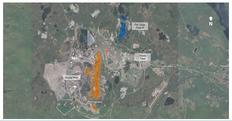- The Kiruna deposit contains over one million tonnes of rare earth oxides.
- Mining could start in 10-15 years, with an exploitation concession application planned for 2023.
- The deposit includes high-grade phosphorus, essential for mineral fertilizers.
- LKAB plans a circular industrial park in Luleå, with production starting in 2027.

Significant Rare Earth Deposit in Kiruna
LKAB has identified over one million tonnes of rare earth oxides in the Kiruna area, Sweden. These metals are essential for manufacturing electric vehicles and wind turbines. This discovery marks the largest known deposit of its kind in Europe.
Future Mining Plans
Currently, no rare earth elements are mined in Europe, and demand is expected to increase significantly due to electrification. LKAB plans to submit an application for an exploitation concession in 2023. However, it will take at least 10-15 years before mining can commence and raw materials can be delivered to the market.
Geopolitical and Supply Chain Implications
Europe is heavily dependent on imports of rare earth elements, with China dominating the market. This dependency poses a risk to European industry, especially with increasing geopolitical tensions. The European Commission projects a more than fivefold increase in demand for these elements by 2030.
Environmental and Technical Challenges
LKAB is preparing to investigate the deposit further, including a drift several kilometers long at a depth of approximately 700 meters. The company acknowledges the challenges related to land use and environmental impacts, which will need thorough analysis before proceeding with mining operations.
Phosphorus and Future Projects
The Per Geijer deposit also contains high-grade phosphorus, a critical nutrient for mineral fertilizers. LKAB is planning a circular industrial park in Luleå to start production in 2027, focusing on extracting and processing phosphorus, rare earth elements, and fluorine from existing mining production.

